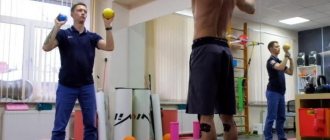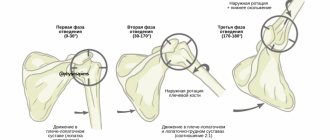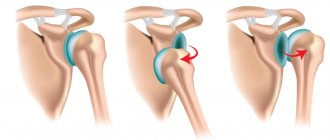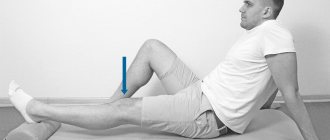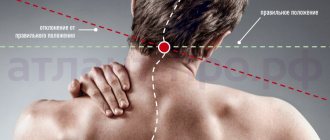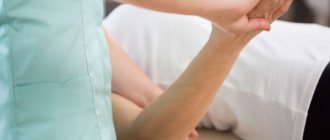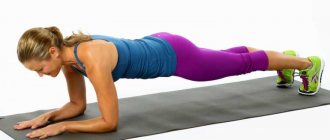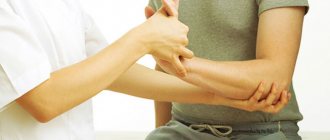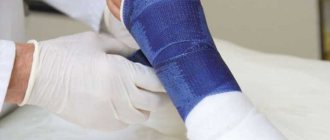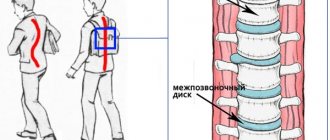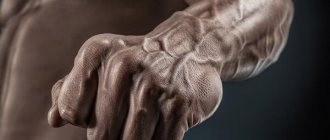Getting a dislocation is a matter of a few seconds: an unsuccessful fall on an outstretched arm, a sudden unsuccessful movement, a collision. Injury to the shoulder joint can occur in both childhood and old age. The cause most often is a weakened or not yet developed ligamentous apparatus, which, when a load occurs, cannot cope, allowing the articular head to jump out of the bag. Treatment will be prescribed depending on the degree of damage received - from simply wearing a bandage and prescribing anti-inflammatory and painkillers to surgical intervention if the dislocation has caused a tear in the muscle and ligament fibers surrounding the joint. Rehabilitation of the patient will be aimed at relieving swelling and getting rid of hematomas, developing, restoring mobility and strengthening the muscles and ligaments surrounding the shoulder joint.
Does a dislocated shoulder require surgery?
The shoulder joint is one of the most mobile in the human body. It is he who gives the hands such a variety of functions. But increased mobility comes at the cost of decreased joint stability. It is explained by the small area of contact between the head of the bone and the glenoid cavity, through which the shoulder is attached to the scapula. As a result, any fall or careless movement can lead to displacement of the joint from the socket, that is, dislocation. In addition to injuries, the cause of dislocation can be:
- Repeated hand movements with maximum range. They are found in some sports (tennis, swimming) and in professions involving manual labor.
- Amateur sports activities with ignorance of the correct technique. The most dangerous are all kinds of rows of barbells or dumbbells behind the head, as well as exercises on the horizontal bar and uneven bars.
- Mineralized joint hypermobility. It is observed in people who naturally have increased flexibility. If you can do the splits without training or bend your fingers more than 90 degrees, you can confidently speak about a predisposition to joint dislocations.
- Dysplasia of the glenoid cavity of the scapula (depth less than normal).
The dislocations themselves can also vary depending on the direction of displacement of the head of the joint. They can be:
- anterior (98% of cases, especially with injuries);
- rear (1-2%, more often when falling on a straight arm);
- lower (they are extremely rare; they can be identified by their inability to lower their hand down).
It is important to be able to recognize the symptoms of a shoulder dislocation. These include:
- Pain.
- Deformation of the shoulder joint area. It becomes more rounded, and if the person is thin, you can even feel the protruding head of the bone.
- Impaired sensitivity of the hand and forearm, manifested in numbness. It is caused by swelling or pinched nerve.
If you notice symptoms of a dislocation, you should never try to straighten your shoulder yourself. You can easily confuse a fracture with a dislocation, or create this very pearl with the wrong reduction technique, as well as damage nerves or blood vessels. First aid consists of hanging the injured limb in a bandage and promptly referring it to a specialist.
Indications for surgery
The need for surgery will depend on how quickly you see a doctor. If you go to the emergency room immediately, in most cases you can get away with closed, non-surgical reduction of the dislocation. But after a day, putting the joint in place becomes problematic due to muscle contraction. In this case, an attempt is made to straighten the shoulder under anesthesia using relaxing drugs. But, as a rule, you still have to resort to surgery, opening the joint and straightening it in an open way.
Surgery may also be prescribed depending on the characteristics of the injury. Prerequisites for surgical intervention are:
- Bone fracture.
- Ligament or tendon rupture.
- Damage to the joint capsule.
- Severance of the articular labrum (cartilaginous tissue that provides better contact between the articular surfaces).
An indication for surgery is also a habitual dislocation of the shoulder. This is the name for repeated displacement of a joint some time after the first dislocation. If this happened a second time, then there will definitely be a third, fourth, etc. And each time the tissues will become more and more damaged. Exercises to restore the functions of the joint will help to avoid repeated dislocation of the shoulder after reduction, but if this was not taken care of in advance and a relapse occurs, then only surgery will correct the situation.
There is no need to be afraid of modern shoulder joint surgeries, as they are performed arthroscopically without traditional incisions. Several punctures are made in the shoulder. A video camera is inserted through one of them, and through other instruments, allowing the restoration of damaged tissue.
Both surgery and conventional reduction require further immobilization of the joint, and only after several weeks can massage, therapeutic exercises and other types of rehabilitation measures begin.
Classification of shoulder injuries
Damage to the shoulder occurs due to a fall, a blow to the joint, or too sudden movements during sports and in everyday life. The most common injuries to the shoulder joint:
- Injury;
- Fracture of the humerus inside or near the joint capsule;
- Dislocation;
- Ligament sprain;
- Rupture of ligaments, tendons;
- Severance of part of the cartilage - the labrum;
- Rupture of the joint capsule.
Dislocation is one of the most common injuries of the shoulder joint, since its articular surfaces touch over a small area. If, due to congenital anatomical features, the contact area is further reduced or there is increased extensibility of the ligamentous apparatus, then a habitual dislocation of the shoulder is formed. It occurs even with slight effort or awkward movement.
Depending on where the head of the humeral bone shifts in relation to the glenoid cavity, anterior, posterior and inferior dislocations are distinguished. Anterior displacement is most common.
Peculiarities!
Habitual dislocation, complicated fracture, rupture of intra-articular structures are indications for surgical treatment.
Rehabilitation after reduction
The first stage of rehabilitation after a shoulder dislocation should always be immobilization, that is, applying an immobilizing bandage to the joint. Previously, plaster casts were used for this purpose, but they bring so much discomfort to the patient that in modern practice they are increasingly being replaced with more comfortable sling bandages. There is also a type of immobilization with abduction, when the arm bent at the elbow is not pressed to the body, but is positioned perpendicular to it. This method of wearing a bandage is less comfortable, but reduces the likelihood of re-dislocation from 40% to 25%.
Depending on the severity of the injury, immobilization should last from 1 to 4 weeks. During this period, the patient undergoes a course of anti-inflammatory drugs. Physiotherapeutic treatment is prescribed as an additional method of treating dislocation. It is used to relieve swelling, relieve pain and resolve pleural effusion (fluid accumulation in tissues).
After removing the bandage, the stage of restoration of joint function begins. Massage will be beneficial here, with the help of which you can relieve muscle tension. As well as continuing the course of physiotherapy, but with the goal of normalizing blood circulation and accelerating restoration processes in tissues. But the main element at this stage of rehabilitation is still physical therapy (PT). It includes exercises for developing the shoulder, aimed both at restoring joint mobility and toning the muscles that have atrophied from immobilization.
Rehabilitation after surgery includes all the same steps as with closed reduction of the joint. It can differ only in a longer period of immobilization.
Nutritional Features
When a shoulder joint is dislocated, a nutritious and balanced diet helps speed up recovery . It should be aimed at strengthening bone tissue, ligaments and joints.
The menu should contain a sufficient amount of proteins, fats and carbohydrates. You should also be sure to take vitamins and minerals.
Proteins are required for the construction of new tissues. It is especially useful to eat dairy products, which ensure the restoration of the cartilage that envelops the joints of the bones.
Milk protein is highly digestible . In addition, such products include a lot of calcium, which is needed to strengthen bone tissue.
The menu should include lean varieties of meat and fish . It is also very healthy to eat buckwheat, beans and lentils. Eating these products boiled, baked or stewed will help improve the absorption of proteins.
It is also useful to eat jelly and jellied meat. These foods include collagen, which provides excellent strength to cartilage and bones.
In order for the body to receive sufficient energy, it is necessary to eat carbohydrates . It is important to eat foods that contain complex carbohydrates. These include vegetables, fruits and grains.
The diet should also contain fats, which are necessary for the normal course of metabolic processes . Preference should be given to butter and vegetable fats.
Refractory fats that are present in meat disrupt blood flow and lead to the appearance of cholesterol plaques on the walls of blood vessels.
When creating a menu, you must follow these rules:
Products should improve metabolic processes. It is recommended to eat meat and fish boiled. You should not eat soups with strong meat broth, since it contains a lot of purine bases. These substances negatively affect the condition of the joints. To normalize water-salt metabolism, pumpkin and zucchini dishes are useful. You also need to eat greens, watermelons, dried apricots and prunes. Raw foods should be consumed 3 times more than those that have been heat-treated. To normalize intestinal function, you need to eat fiber. It is present in cereals, vegetables, fruits, wholemeal bread. Instead of regular tea, you need to drink dried fruit compote or rosehip decoction. Drinking herbal teas is also very beneficial.
How can exercise therapy help?
Therapeutic gymnastics is used at the most important stage of rehabilitation - restoring the functionality of the joint. But some exercises need to be started during the rest period. Immediately after a shoulder dislocation, exercise therapy consists of developing the muscles of the hand and forearm. This will allow them not to atrophy during the period of fixation of the shoulder joint.
In the first days after removing the fixing bandage, the patient experiences protective reflex tension in the muscles. It arises due to a subconscious fear that the joint will fall out again. Therefore, during this period it is allowed to perform movements only using a fabric scarf. Gymnastics consists of raising and lowering the forearm, bringing and spreading the shoulder blades, circular movements of the shoulder joint and other simple exercises. In this case, swings and other sudden movements are excluded. The early post-immobilization period usually lasts 10-20 days.
Next comes the late post-immobilization period, which can last up to 1.5 months. Here the emphasis is on strengthening the muscles, as well as increasing the range of motion through stretching. Stretching exercises for shoulder dislocations must be done extremely carefully so that the muscles are stretched without damaging the fragile joint capsule. Towards the end of the period, it is recommended to perform exercises with additional weights or an elastic expander.
The total recovery period from the moment of injury is about 3 months. However, for athletes and people whose work involves stress on their hands, rehabilitation can be extended up to six months, since more functions are subject to restoration.
Question to the doctor
How do you know when you need to see a doctor?
Hello, my name is Vadim. Not long ago I had a dislocated shoulder, I was in a trauma center about this, they put it in place for me, but the traumatologist warned me that now there is a greater chance of repeated dislocations.
Two months have passed since then, but just the other day after playing basketball I felt a sharp pain in my arm, similar to the one that arose for the first time. But I don’t see a complete dislocation, as it was. What should I do?
Good afternoon, Vadim. Thank you for your question. After an acute dislocation of the shoulder joint, you should not wait for a possible recurrence of this condition, but do everything possible to prevent it. This can be done with the help of an orthopedic consultation and physiotherapeutic procedures. Exercises to strengthen the shoulder joint after its dislocation are indicated for every patient in a similar situation.
In your situation, subluxation in the joint is possible, but this is only an assumption that can only be confirmed or refuted by a specialist. Do not hesitate to consult a doctor, as such pathologies must be treated in a timely manner to prevent complications.
Treatment at home
Hello. My name is Olga and I have been scheduled for surgery due to the fact that I have had a recurring shoulder dislocation for two years now. The doctor said that in my case there is no other option other than surgery. Tell me, please, is there still some kind of ointment for the shoulder and a special bandage to avoid surgery?
Good afternoon, Olga. In fact, no ointment will help solve the problem of repeated dislocation of the shoulder joint. Only the attending orthopedic surgeon can decide which option is most suitable in your case.
A set of exercises after a shoulder dislocation
What set of exercises is needed after a shoulder dislocation should be determined by the doctor in each specific case. For information purposes only, we will provide examples of therapeutic exercises for each of the periods of rehabilitation. Before you start following the recommendations, be sure to discuss them with a specialist.
Exercises during immobilization
During the period of immobilization of the injured limb, the mobility of the hand and forearm can be maintained with the help of exercise therapy. To do this you need to do the following exercises:
- Active movements in the joints of the fingers and wrist. The brush can be squeezed and unclenched, moved in a circle, or simply moved with your fingers.
- Creating tension in the forearm muscles by clenching the hand into a fist.
The first type of movement can be started from the first day after realignment of the joint. Their execution time is not limited. Tension exercises are more complex, and you should start doing them no earlier than 2-3 days after the injury. At first, you can strain your hand for no more than 1 second, gradually increasing this time to 5-7 seconds.
Exercise therapy in the early post-immobilization period
At this stage, to restore the mobility of the joint freed from the bandage, the safest exercises are used, excluding sudden movements of the hands. These include:
- Raising the shoulder and making light circular movements with it in a limited amplitude.
- Reduction and dilation of the shoulder blades.
- Forearm flexion.
- Self-resistance exercise. It is done from a sitting position with the affected arm bent at the elbow and resting on the thigh. You need to try to lift it up, press it to yourself, push it forward or back, each time holding it with your healthy hand. That is, in fact, only muscle tension occurs, and the limb itself remains motionless.
Classes should be carried out 3-4 times a day for 15-20 minutes.
Training at the last stage of recovery
The last stage of rehabilitation should begin with multidirectional movements of the injured limb:
- raising a straight arm in front of you, up and to the side;
- putting your hand behind your back;
- circular swings, etc.
Intensive shoulder training after a dislocation is carried out 2-3 times a day. Starting from 15 minutes, the duration of the lesson must be gradually increased, bringing it to 30 minutes.
As soon as exercises with your own weight begin to be easy, you can add weights. For starters, 0.5 kg dumbbells are suitable. They can be used in the following exercises:
- In a standing position, we raise our arms with dumbbells on the sides to shoulder level, then bend them at the elbows at an angle of 90 degrees and, due to the movement in the elbow joint, begin to raise and lower the dumbbells up and down.
- Lying on your side, place the sore arm on the floor in a position bent at an angle of 90 degrees. Raise the dumbbell towards the body and back.
These exercises are aimed at strengthening the small muscles of the shoulder, which are responsible for stabilizing the joint. They must be performed in 3 sets of 30-50 repetitions.
Restoring the shoulder joint can also be done in the gym. This does not require special exercises. You can do your usual shoulder training, but with minimal weights.
You will learn more about exercise therapy after a shoulder dislocation and other injuries from the video:
Traditional methods
Home recipes are used to relieve pain. They also help restore mobility of the affected joint and cope with swelling.
It is very important to use folk remedies systematically. Otherwise, it will not be possible to achieve the desired results.
The most effective home remedies include the following:
Take bryonia root, dry and chop . Pour half a small spoon into 500 ml of water and place on the stove. Cook for a quarter of an hour, then cool and strain the broth. Add a large spoon of the resulting product to half a glass of sunflower oil. This composition is ideal for rubbing the affected area. To restore shoulder mobility, tansy should be used . To do this, it is recommended to take 3 tablespoons of the flowers of this plant. It is recommended to mix them with boiling water and leave for 1 hour. Then the composition should be filtered and used for wet compresses. Cornflower has a good analgesic effect . To make a useful composition, you need to take 3 small spoons of flowers, mix with 500 ml of boiling water and leave for 1 hour. Strain and cool the broth. It can be taken orally half a glass 3 times a day. This should be done before meals. An ointment is considered a good remedy, which is often used during the recovery stage. To prepare it, you should take 100 g of propolis and vegetable oil . Mix the ingredients and heat in a steam bath. Turn off after the propolis has dissolved. Apply the cooled product to the affected areas. This composition can be stored for no more than 90 days. A composition based on barberry root and bark will help you cope with habitual shoulder dislocation . These ingredients should be crushed and mixed thoroughly. Take 1 small mixture, mix with a glass of milk and bring to a boil. Take 1 small spoon three times a day. The composition has a pronounced strengthening effect. Alcohol tinctures have an excellent effect. They can contain a variety of ingredients. So, you can prepare mountain arnica tincture . To do this, it is recommended to take 20 g of plant flowers and add 200 ml of alcohol. Leave to infuse for a week, then strain. Take half a small spoon twice a day. A good remedy is a composition based on sugar and onions . This vegetable should be used fresh or baked. To make the medicinal composition you will need 1 onion and 10 small spoons of sugar. The ingredients must be mixed and used as lotions. It is recommended to change the dressing every 5-6 hours. Elecampane root has an excellent effect . The raw materials should be crushed, add a glass of boiling water and leave to infuse for half an hour. Use the resulting decoction for compresses and lotions. A tincture of ficus leaves is considered a good remedy . To make it, you need to chop 1 leaf of the plant and pour in 250 ml of vodka. Leave to infuse for a couple of weeks. This should be done in a dark and cool place. Put 1 large spoon of honey and an egg yolk into the strained mixture. Rub the resulting composition into the affected area before going to bed. After which it is recommended to wrap the affected shoulder with a warm scarf. The course of therapy should be continued for 2 weeks and then take a break. If necessary, treatment can be repeated.
Main types of physiotherapy
To restore a dislocated shoulder, a whole range of physiotherapeutic procedures is used. To relieve pain use:
- UV irradiation;
- amplipulse therapy (rhythmic exposure to alternating current).
Inflammation is relieved with:
- high-frequency exposure to a magnetic field;
- UHF and microwave treatments.
To improve blood supply to a diseased joint, use:
- electrophoresis;
- IR radiation;
- paraffin therapy (application of warm paraffin applications).
To accelerate the regeneration of damaged tissues, the following is prescribed:
- laser therapy;
- magnetotherapy.
The use of physiotherapy is contraindicated in cases of severe internal hemorrhage. In this case, treatment can begin only after removing fluid from the joint cavity.
Using massage for muscle rehabilitation
Massage is usually used in conjunction with exercises to strengthen arm muscles weakened after a shoulder dislocation. But you can resort to his help much earlier - 3-4 days after the joint has been realigned. During this period, massage will help get rid of swelling and speed up the process of resorption of hematomas. The procedure includes light stroking, pinpoint pressure and rubbing. It must be performed exclusively by a specialist. Self-massage, especially at the initial stage of recovery, is more likely to lead to additional injuries than to have a healing effect.
Massage will be useful not only for dislocation, but also for subluxation of the shoulder, when there is a slight displacement of the joint. With such an injury, rehabilitation is many times faster, and therapeutic massage can completely reduce this period to a minimum.
General treatments
What to do if you have a dislocated shoulder? Typically, treatment for this condition involves doing the following:
Local anesthesia – helps eliminate pain. To do this, the doctor administers Lidocaine or Novocaine. This stage absolutely cannot be ignored, since reduction is accompanied by severe pain. You should not try to straighten the joint yourself or with the help of loved ones. This can cause its destruction and even fracture. Repositioning the hand . This is a difficult and painful stage. There are several reduction methods. The doctor must choose a specific method, otherwise there is a risk of unpleasant consequences. Surgical intervention . This method is used if it is not possible to straighten the joint using the usual method. In such a situation, it is fixed with sutures and knitting needles. This intervention is performed under general anesthesia. Immobilization of the joint . This will help eliminate the risk of relapse and ensure rapid healing. A splint is applied to the affected area. You will have to wear the device for 1-2 months - it all depends on the severity of the injury. Rehabilitation . It is forbidden to ignore this stage, since it allows you to strengthen and restore the joint, as well as prevent its re-damage. For this purpose, gymnastics, massage and other therapeutic procedures are used.
After complete recovery, care must be taken. To do this, you should avoid putting any stress on your injured arm and try to eliminate situations in which you could get injured.
Sports supplements for faster recovery
Recovery from injury can be significantly accelerated by taking sports supplements. In such cases, chondroprotectors should be used - drugs that regenerate the cartilage tissue of the joint. The most effective of them are:
- Chondroitin. Restores cartilage and increases the amount of synovial fluid and collagen, thereby improving joint mobility.
- Glucosamine. In addition to active regeneration of cartilage tissue, it promotes increased production of hyaluronic acid, which improves joint gliding.
- Methylsulfonylmethane. Sulfur based additive. Restores the integrity of connective tissues and has a mild analgesic effect.
- Alflutop. Made from small marine organisms. Regenerates cartilage, normalizes metabolism, relieves pain and inflammation.
Doctors often prescribe American drugs to their patients, such as Teraflex or Artra. But they are based on the same chondroitin and glucosamine, so there is no point in overpaying.
Taking chondroprotectors not only speeds up recovery, but also reduces the likelihood of re-injury. In addition to them, it is necessary to take a vitamin-mineral complex, since the construction of new tissues requires an increased supply of nutrients.
For those who are just deciding whether they need sports nutrition, we recorded a video below:
We recommend: an online sports nutrition store in Moscow with the coolest consultations! Delivery to the regions.
Exercises to restore joint mobility
When compiling a complex for developing joint mobility, you will be selected exercises with simple mechanics of movement that will help develop a healed shoulder joint that has lost tone and has undergone atrophy due to immobilization. Arm raises, lateral abduction, rotations - the difficulty will increase gradually, allowing the muscles and ligaments to adapt to the load and restore the normal secretion of interarticular fluid, which will provide shock absorption and lubrication to the joint. The development of a shoulder joint that has been dislocated can be lengthy in cases where the injury was severe with severe damage to the articulation.
Bandages, fixators, special exercise equipment—rehabilitation of a patient with a dislocated shoulder joint requires special tools. In the Heart online store you will find all the necessary care devices that will help you and your loved ones regain their health faster after a shoulder injury. With these products, treatment at home will be much easier for the patient and the people caring for him.
